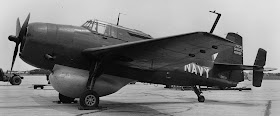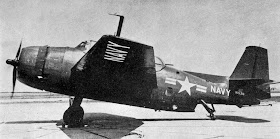Rick Morgan (http://rickmorganbooks.com/index.html) and I have continued to explore the poorly documented post-war history of the various variants of the Eastern Aircraft TBM-3. The Navy still had lots of them after the war. Since they were big and easily modified, they were readily adaptable to other missions besides torpedo, glide, and level bombing that were their raison d'etre.
Most were modified from TBM-3Es. In most cases, the addition of the E would simply mean the addition of electronic equipment, in this case provisions for carrying the APS-4 radar on a stores pylon under the right wing. However, the designation is also associated, possibly coincidentally, with a redesign by Eastern to reduce weight by about four hundred pounds. One of those changes was probably the location of the tailhook, which had been internally housed on all TBFs and prior TBM production. Most TBM-3Es delivered from Eastern probably had the external tailhook. This is an example.
There is evidence that the weight reduction effectivity in production (like the tailhook change, deletion of tunnel gun provisions and some armor, etc.) was not the same as for the APS-4 provisions. As a result, the first production -3Es did not have the external tailhook. It is also possible, even likely, that TBM-3s were subsequently modified to the E configuration (i.e. APS-4 provisions) at Navy repair and overhaul facilities but retained the internal tailhook.
Based on the information provided on Joe Baugher's invaluable listing of Bureau Numbers (see http://www.joebaugher.com/navy_serials/navyserials.html) and elsewhere, it appears that one TBM-3E production lot used a block of Bureau Numbers from a cancelled BuAer contract:
Bureau Numbers Mfg Number Model
22857-23656 1-800 TBM-3
68062-69538 801-2277 TBM-3
85459-86292 2278-3111 (834) TBM-3E
53050-53949 3112-4011 (900) TBM-3E
91107-91752 4012-4657 (646) TBM-3E
These out-of-sequence BuNos explain why many "older" TBM-3Es, i.e. with 53XXX BuNos, are configured with an external tailhook even though its effectivity reportedly occurred at either BuNo 85566 or 86175. It also explains erroneous statements to the effect that most TBM-3Es did not have the external tailhook when in fact most do.
For sure there are TBM-3Es with the APS-4 radar and an internal tailhook. In his comment below, Pablo Montero provided a link to this example, which is reportedly a VMTB-234 Avenger circa 1945. It looks like there is an E at the end of the type designation on the vertical fin but as is frequently the case, the BuNo cannot be read.
The next interesting issue is the alphabet soup of TBM-3 variants. A suffix was used when a change was "major" and intended to be permanent, with occasional exceptions (see TBM-3J below). Note that there was no TBM-3B or -3C whereas there was a TBM-1B and -1C; this appears to have been because B stood for a British version and C was apparently an armament change (the -1C deleted the single cowling mounted machine gun in favor of one in each wing outboard of the propeller arc). There was a TBM-1D with a permanently mounted APS-3 radar on the right wing, which is apparently why the similar -3 conversions were designated -3Ds. These were a late-war modification to add an APS-3 radar on the right wing and ECM (Electronic Counter Measure) equipment. The gun and associated hardware was removed from the turret and the lower compartment by VT(N)-90 to reduce weight since its primary mission was night attack.
Some other well-known variants:
TBM-3W: A late-war modification to add an APS-20 radar in a large belly-mounted radome for airborne early warning. Some were converted from TBM-3s like 89471 so it had an internal tailhook.
Some were converted from TBM-3Es like 53894 so it had an external tailhook.
TBM-3R: A Korean War-era modification for COD (Carrier On-board Delivery); see http://tailhooktopics.blogspot.com/2013/01/tbm-3r-cod.html
TBM-3S: A post-war modification to remove the defensive armament and add ASW mission equipment. It was teamed with a TBM-3W variant to provide submarine hunter-killer capability as a placeholder for the AF Guardian. There were variations in the mission equipment and the canopy modification (one was designated TBM-3S2 to distinguish it from the 3S). Note that a crewman now occupies the compartment aft of the pilot.
TBM-3U: A TBM-3 modified to tow targets and for general utility use. All offensive and defensive hardware was removed and a tow reel was permanently installed in the aft fuselage. The tow target was presumably streamed out from the former stinger gun location just ahead of the tail wheel.
Note that BuNo 69400 was probably delivered from Eastern as a -3 and subsequently modified to carry an APS-4 radar pod under the right wing.
TBM-3J was a TBM-3E with provisions for installation of a tow target reel. The concept was that it could deploy with an air group and provide tow target services when required. It was therefore not, as can be found on internet, a TBM-3 equipped for all-weather operations, i.e. with wing and tail surface deicing.
Less well known and sometimes misidentified are the TBM-3N (see http://thanlont.blogspot.com/2015/07/tbm-3n-versus-tbm-3q.html) and TBM-3Q (see http://rickmorganbooks.com/tbm-3q-avenger.html). For example, as Rick points out in his excellent post on the latter, it did not have a belly-mounted radome like the TBM-3W as usually stated in TBM books and online summaries.
And then there are the TBM variants for which we have yet to find documentation, much less photographs. Through the magic of copy and paste, these are identified on many web sites as follows:
TBM-3H: TBM-3 modified for surface search radar
TBM-3L: TBM-3 equipped with a retractable searchlight in bomb bay
TBM-3M: TBM-3 conversion as missile launcher
TBM-3P: TBM-3 conversion for photo-reconnaissance
Of these five, for sure the TBM-3P and TBM-3L are correctly identified per Navy documentation dated November 1944.
The TBM-3P was a TBM-3 "equipped with a trimetregon (sic) camera". Rick Morgan has found "less than 10" in CASU (Carrier Aircraft Service Units) pools in San Diego and Pearl Harbor in the 1946 Allowance Lists (some are listed as TBM-3EP, which suggests that "TBM-3Ps" were converted from TBM-3s). CASUs were repair and maintenance centers at some naval air stations; they were also a storage point for airplanes that could be issued to squadrons to replace attrition. The trimetrogon camera installation actually utilized three cameras, left and right oblique and vertical, taking pictures simultaneously. This is the installation in a B-17 (see https://historicairphotos.wordpress.com/2014/05/21/trimetrogon-photography/)
The TBM-3P camera installation was probably located in the lower (radioman's) compartment. Since mapping, as opposed to strike-damage assessment, was not a primary air-group mission, the TBM-3P was probably little utilized and appears to have had a short career. No pictures of one have been identified as such.
The same document lists the TBM-3L as a "TBM-3, 3D, or 3E equipped with a searchlight mounted in the bomb bay". Note that the TBM-3D had provisions for a searchlight mounted on a pylon under the left stub wing but since this was "detachable", the suffix L did not apply. (In any event, utilizing the bomb bay for this purpose seems counterproductive, which may be why there aren't too many pictures of the type—I have yet to see one.)
The description of each of the other two TBM variants is dubious. A Navy History and Heritage Command document (HERE) does not list the H and the M and identifies the J as a "utility plane", which it was since it could be configured with a tow-target capability.
At the time, the suffix H was used to designate an airplane modified to be a "hospital", i.e. to transport wounded personnel. That's a possibility, although no TBM-3Hs have been identified. There was reportedly a modification of the TBM-3W's radar to optimize it for submarine-snorkel detection but this would have, if anything, probably resulted in a modification to the existing designation (there is a TBM-3W2, for example).
There may have been TBMs with deice boots but they were not designated TBM-3Js. As noted above, these were TBM-3Es modified with provisions for target towing, the forerunner of the TBM-3U. However, they retained the carrier-basing and ordnance capability; as a result, the designation of a TBM with this capability depended on whether the tow equipment was installed or not! See the June 1947 issue of Naval Aviation News.
The TBM-3M, if there were any, was more likely a modification for weather reconnaissance like the PB4Y-2M, which was the purpose of the suffix at the time. None have been identified.
On the other hand, there are a couple of TBM modifications that we have pictures of but little or no additional information. The first is something in the bomb bay of TBM-3E BuNo 91704 in a picture provided by Jim Hawkins via Steve Ginter. It looks like there is an opening at the bottom of the aft end of the pod and what might be static discharge wicks or antennas on the bottom of the pod. It could be an early ECM pod installed on this TBM for inflight testing.
Another is a TBM marked as a -3E, reportedly BuNo 69465 at Pax River on 18 January 1946, provided by Jim Sullivan (the TT on the cowling indicates that it was assigned to the Tactical Test division at the time). It was reportedly an attempt by Eastern to compete with the new single-seat BT—soon to be changed to A for attack—airplanes from Douglas, Martin, et al.



















